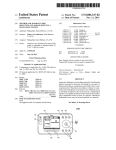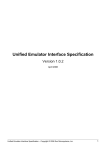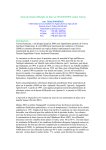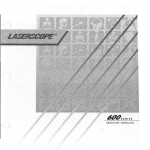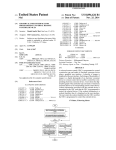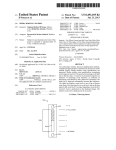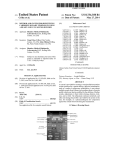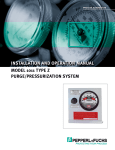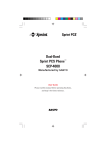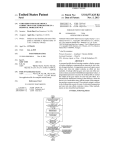Download Systems and methods for accurate measurement with a mobile device
Transcript
US008836703B2 (12) United States Patent (10) Patent N0.: (45) Date of Patent: Venon et al. (54) (56) SYSTEMS AND METHODS FOR ACCURATE US 8,836,703 B2 Sep. 16, 2014 References Cited MEASUREMENT WITH A MOBILE DEVICE U.S. PATENT DOCUMENTS (75) Inventors: Medhi Venon, White?sh Bay, WI (US); 2006/0104545 A1 * 5/2006 Christopher Janicki, Barrington, IL 2008/0036693 A1 * 2/2008 Driver et al. (Us) 2011/0122139 A1* 2012/0127131 A1* 5/2011 5/2012 Schenectady, NY (US) Appolicious iPhone and iPad App Directory “Calgary Scienti?c: Res MD Application for Smarphone and Tablet PC” http://wwwappoli cious.c0m/hea1th/apps/l74234-res01utionmd-m0bile-calgary-scien Subject to any disclaimer, the term of this patent is extended or adjusted under 35 ti?c (Last Accessed on Aug. 23, 2012). “OsiriX HD User Manual” http://WWW.0sirix-viewer.c0m/iph0ne/ U.S.C. 154(b) by 421 days. Manual .pdf (Last Accessed Aug. 23, 2012). (21) App1.No.: 13/236,948 * cited by examiner (22) Filed: Assistant Examiner * Nurun N Flora Primary Examiner * Kee M Tung Sep. 20, 2011 (74) Attorney, Agent, (65) Prior Publication Data US 2013/0069946 A1 (51) Mar. 21, 2013 and methods to facilitate display, revieW, and annotation of image data on a small display. An example method includes determining an initial display resolution by comparing an image dimension at an image display resolution and an avail able screen dimension of the reduced size display screen. The example method includes, based on a selected region of inter est in an image, displaying the selected region of interest at vs. C]. CPC ............. .. A6IB 5/00 (2013.01); G06T 2210/41 the initial display resolution. The example method includes, using the selected region of interest, displaying image data in (2013.01); A613 5/743 (2013.01); A613 5/1075 (2013.01) USPC (58) the selected region of interest to set a plurality of data points via user interaction With a touchscreen display. The example ......................................... .. 345/428; 382/286 Field of Classi?cation Search method includes computing a potential error introduced for a measurement between the plurality of data points based on a CPC ..... .. H04N21/00; H04N21/20; H04N 21/40; H04N 21/60; H04N 21/80; G06T 2211/40; G06T 2211/404; G06T 2211/416; G06T 2211/024; G06T 2211/028; G06T 2211/004; tolerance value. The example method includes adjusting the image display resolution and zoom based on the potential error. G06T 2211/41 See application ?le for complete search history. 24 Claims, 5 Drawing Sheets 100 A camera 3:51 PM 109 :1 Flight and ABSTRACT Certain examples provide collaboration systems, apparatus, (2006.01) (2006.01) (2006.01) (2006.01) A61B 5/107 (52) or Firm * Hanley, Zimmerman, LLC (57) Int. Cl. G06T 17/00 G06K 9/36 A613 5/00 345/l.3 Lee et al. ..... .. 345/441 Jung et al. ................... .. 345/178 OTHER PUBLICATIONS (73) Assignee: General Electric Company, Notice: Matsumoto ................. .. 382/302 a (Barrier? 3:51 PM 100 if” ’ , 15‘: 7- v15- . 130 ,3 Carrier? 3:51 PM / m . ‘5 140 v/ Q 2.0, . 145 US. Patent Sep.16,2014 SheetlofS US 8,836,703 B2 US. Patent Sep. 16, 2014 200\ Sheet 2 0f5 US 8,836,703 B2 \ ACCESS DEVICE 220 COLLABORATION ACCESS DEVICE 230 — ENGINE — E CLINICAL SUBSYSTEM @ FIG. 2 300 \ 310 DISPLAY INTERFACE E PROCESSOR @ COMMUNICATION INTERFACE @ MEMORY E FIG. 3 US. Patent Sep. 16, 2014 Sheet 3 0f5 US 8,836,703 B2 400 RETRIEVE AN IMAGE FOR DISPLAY N410 ON A SMALL SCREEN I DETERMINE AN INITIAL RESOLUTION N420 FOR IMAGE DISPLAY I DETECT A TOUCH ON THE SMALL DISPLAY WITH RESPECT TO THE IMAGE N430 I DETERMINE AN ERROR WITH RESPECT TO THE TOUCH ON THE DISPLAY @440 I COMPUTE A MEASUREMENT BETWEEN TOUCHES ON THE DISPLAY W450 I DETERMINE A DISPLAYED IMAGE RESOLUTION AJ460 I APPLY THE IMAGE RESOLUTION TO [V470 THE IMAGE DISPLAY FIG. 4 US. Patent 500\ Sep. 16, 2014 US 8,836,703 B2 Sheet 4 0f 5 \ DETERMINE AN AVAILABLE AJ51O DISPLAY RESOLUTION DETERMINE A MEASUREMENT TOLERANCE AV 520 DETERMINE AN AREA OF AN IMAGE TO DISPLAY N/ 530 J 540 DISPLAY THE IMAGE AREA I ACCEPT USER INTERACTION WITH N550 THE DISPLAYED IMAGE AREA FIG. 5 600 62 610 Q a EXTERNAL SYSTEM DATA STORE 630 Q 640 % @ 5 ACCESS DEVICE USER INTERFACE 6S0 ACCESS DEVICE \645 FIG. 6 USER INTERFACE \ 655 US. Patent Sep. 16, 2014 Sheet 5 0f5 US 8,836,703 B2 / 700 PROCESSOR /“v 702 704 Q 716 726 HQ > DEVICE l/O 710V CONTROLLER 708 p MEMORY CONTROLLER 722 I I/O DEVICE | SYSTEM MEMORY > K 712 a <\ 718 720 MASS STORAGE MEMORY 3 714 FIG. 7 NETWORK INTERFACE > US 8,836,703 B2 1 2 SYSTEMS AND METHODS FOR ACCURATE MEASUREMENT WITH A MOBILE DEVICE using a processor, an initial display resolution by comparing an image dimension at an image display resolution and an available screen dimension of the reduced size display screen. The example method includes, based on a selected region of FIELD interest in an image, displaying the selected region of interest at the initial display resolution. The example method The present generally relates to computerizing reading and review of diagnostic images. More particularly, the present includes, using the selected region of interest, displaying image data in the selected region of interest to set a plurality of data points via user interaction with a touchscreen display. The example method includes computing, using a processor, invention relates to annotation and measurement of diagnos tic images on mobile devices. BACKGROUND a potential error introduced for a measurement between the plurality of data points based on a tolerance value. The example method includes adjusting the image display reso In many cases, in order to diagnose a disease or injury, a medical scanning device (e.g., a computed tomography (CT) lution and zoom based on the potential error. scanner, magnetic resonance imager (MRI), ultrasound machine, etc.) is used to capture an image of some portion of a patient’s anatomy. After the acquisition of the image, a Certain examples provide a system including a touch screen interface to display image data and accept user input with respect to the image, the user input to include a plurality trained physician (e.g., radiologist) reviews the created of data points based on user touches on the interface with images (usually on a computer monitor), renders an interpre tation of ?ndings and prescribes an appropriate action. This example becomes more complex in that current diagnostic respect to the image. The example system includes a memory 20 imaging departments provide extensive information regard ing the human anatomy and functional performance pre sented through large numbers of two- and three-dimensional images requiring interpretation. Diligent interpretation of to store instructions and data. The example system includes a processor to process user input from the touchscreen inter face. The processor is to determine an initial display resolu tion by comparing an image dimension at an image display 25 resolution and an available screen dimension of the reduced size display screen; based on a selected region of interest in an these images involves following a strict work?ow, and each portion of the work?ow presumes visual presentation in a image, display the selected region of interest at the initial certain order of a certain image series from one or multiple play image data in the selected region of interest to set a plurality of data points via user interaction with a touchscreen display resolution; using the selected region of interest, dis exams and application of certain tools for manipulation of the images (including but not limited to image scrolling, bright 30 ness/contrast, linear and area measurements, etc.). Often, a second opinion from a specialist or peer in the same ?eld is involved, and the person may not be physically present at the display; compute a potential error introduced for a measure ment between the plurality of data points based on a tolerance value; and adjust the image display resolution and zoom based on the potential error. same workstation to view the same images. In order to com pensate for this, the remote physician might have to use some function to perform quantitative or qualitative measurements on the image. With the current remote mobile solution based on touch screen interfaces, the accuracy and repeatability of the measurements are compromised. 35 40 BRIEF SUMMARY BRIEF DESCRIPTION OF SEVERAL VIEWS OF THE DRAWINGS FIG. 1A illustrates an example small display screen pro vided via a mobile or handheld device displaying an image. FIG. 1B shows an example selection of a zoom factor via either a main view or a picture-in-picture view. FIG. 1C demonstrates an example “long tap” to switch image display and magni?cation between the primary view Certain embodiments of the present invention provide sys tems, apparatus, and methods for image review and annota tion a device having a limited or smaller display size. 45 Certain examples provide a computer-implemented method for image display via a device having a reduced size display screen. The example method includes determining, using a processor, an initial display resolution by comparing an image dimension at an image display resolution and an available screen dimension of the reduced size display screen. 50 command(s) related to the content of the exchanged commu nication. FIG. 3 provides an alternative view of a system for imaging display and review. FIG. 4 illustrates a ?ow diagram for a method for image retrieval and display on a device having a small area for image The example method includes, based on a selected region of interest in an image, displaying the selected region of interest at the initial display resolution. The example method includes, using the selected region of interest, displaying and the picture-in-picture view. FIG. 2 illustrates an example collaboration system provid ing communication exchange and communication content processing to automatically facilitate execution of display. 55 FIG. 5 illustrates a ?ow diagram for a method for deter image data in the selected region of interest to set a plurality of data points via user interaction with a touchscreen display. The example method includes computing, using a processor, mining image display resolution for image data on a device a potential error introduced for a measurement between the use with systems, apparatus, and methods described herein. FIG. 7 is a block diagram of an example processor system that may be used to implement the systems, apparatus and methods described herein. The foregoing summary, as well as the following detailed plurality of data points based on a tolerance value. The having a small area for display. FIG. 6 depicts an example clinical enterprise system for 60 example method includes adjusting the image display reso lution and zoom based on the potential error. Certain examples provide a tangible computer-readable storage medium having a set of instructions stored thereon which, when executed, instruct a processor to implement a method for image display via a device having a reduced size display screen. The example method includes determining, description of certain embodiments of the present invention, 65 will be better understood when read in conjunction with the appended drawings. For the purpose of illustrating the inven tion, certain embodiments are shown in the drawings. It US 8,836,703 B2 3 4 should be understood, however, that the present invention is not limited to the arrangements and instrumentality shown in the attached drawings. an image of some portion of a patient’s anatomy. After acqui sition of the image, a trained physician (e.g., a radiologist) reviews the created images (e.g., on a computer monitor), renders an interpretation of ?ndings, and prescribes an appro DETAILED DESCRIPTION OF CERTAIN EXAMPLES priate action. Diagnostic imaging departments provide infor mation regarding the human anatomy and functional perfor mance presented through hundreds or even thousands of two and three-dimensional images for interpretation, for example. Diligent interpretation of these images involves following a Although the following discloses example methods, sys tems, articles of manufacture, and apparatus including, strict work?ow. Each step of the work?ow presumes presen among other components, software executed on hardware, it should be noted that such methods and apparatus are merely illustrative and should not be considered as limiting. For example, it is contemplated that any or all of these hardware tation of an image or related information on a screen in a certain order of a certain image series from one or multiple exams, and an application of certain tools for manipulation and software components could be embodied exclusively in over the images (such as image scrolling, brightness/contrast, hardware, exclusively in software, exclusively in ?rmware, or linear and area measurements, etc.). Often, a second opinion in any combination of hardware, software, and/ or ?rmware. from a specialist or peer in the same ?eld is requested, and the specialist or peer may not be physically present at the same workstation to view the same images as the requesting clini Accordingly, while the following describes example meth ods, systems, articles of manufacture, and apparatus, the examples provided are not the only way to implement such methods, systems, articles of manufacture, and apparatus. cian. In order to compensate for this, the remote physician 20 When any of the appended claims are read to cover a purely software and/ or ?rmware implementation, at least one of the involve accuracy and repeatability to validate the relevance of the data. Using a remote mobile device including a touch screen interface, accuracy and repeatability of measurement elements in an at least one example is hereby expressly de?ned to include a tangible medium such as a memory, DVD, CD, Blu-ray, etc. storing the software and/or ?rmware. might have to use some function to perform quantitative or qualitative measurements on the image. Such measurements 25 are compromised using prior techniques. Certain examples Certain examples provide systems, methods, and apparatus describe methods, systems, and an end user experience to to provide accurate measurement of image distance(s) using a provide accurate and repeatable data. Certain examples provide systems and methods for easy mobile device. A device including or connected to a small display can be used to measure an image, but dif?culty may arise if the display size is small compared to the image size (e. g., a smaller than ten inch screen). Collaboration and early detection of inaccurate measurement can be enabled by pro and fast collaboration that enables two doctors to collaborate 30 viding more accurate measurement using a small display to show medical images. In certain examples, end users can help ensure that an and exchange information remotely between computer and a mobile device. In certain examples, two or more workstations 35 intrinsic error due incurred through the use of touch inputs is can be used by the doctors with various inputs device involv ing accuracy and repeatability. For example, a radiologist may perform operations to evaluate dimensions of a portion of an image remotely via a mobile device, or the radiologist may make qualitative assessments to complete his or her reduced or minimized compared to a tolerance of a desired readings or diagnostic tasks before sharing results with a measurement. For example, each measurement can be mod primary radiologist and/ or document observation(s) in study eled as: measurement :dié, where d is a measurement made reports. Certain examples provide systems and methods to reduce related to length, perimeter, area or column, and e is an error 40 and/or minimize error introduced by end user(s) during due to a size of a touch on a screen of a mobile device related to an exact position of the desired touch. Each touch can be acquisition of an area for measurement(s). The area of the de?ned as (x+Ax, y+Ay), for example. In cases of multi measurements (e. g., one-dimensional ( l D), two -dimensional touch, an error can be found for each touch. (2D), three-dimensional (3D), . . . nth-dimensional (ND)) is In certain examples, a measurement is de?ned as: 45 de?ned by a group of one or more markers set by the user in measurement:f(Z(pn+6pn)). In certain examples, errors the space-time dimension. Time may be important in some introduced by an input device are reduced or minimized below a tolerance, and a feedback is provided to end-users reading procedures (e.g., diastolic, systolic, echo-doppler, frame with maximum contrast agents, etc.). Each acquisition data done manually by the end users can when the measurement is acceptable. In case of a multiple point measurement such as an angle, a line, etc., each measurement is a function of the set of points. Each point can be represented as an ideal point and an error 50 be model as: pt:f(i_+e), where i is a user input and f(i) represents a transformation function of the user input(s) on an image space representation. If eQO, the point of user input i is accurate and reliable. Certain examples provide and/or introduced by the user and the input device. The variable p” represents the ideal location of the nth point. Additionally, 6p” facilitate a work?ow and user interface to allow a user to is the error introduced by the user and the device. For example, the user error is typically due to the size of the touch 55 minimize or reduce error associated with a user touch point or cursor position on an interface including a small screen or other display. For complex measurements with n data acqui on the interface with the user’ s ?nger and is impacted by the user’s ?nger hiding a region of interest when touching the sition, a tolerance of error can be decomposed on a tolerance screen and the input device. Based on an image viewing area, a screen pixel does not always represent a physical image for each data point, for example. 60 pixel, for example. For example, an image may be scaled to ?t on a display including 320 width pixels. In case of a mammography (e. g., In certain examples, measurement can be used in conjunc tion with diagnostic reading of digital medical exams, such as digital radiology imaging. For example, in many cases in a 17 cm width camera, the 17 cm corresponding to 320 device (e.g., a computed tomography (CT) Scanner, magnetic pixels), the error would be 5 mm, which is quite big to mea sure micro calci?cation in a mammography image. If the tolerance for such measurement is 0.5 mm, the 320 pixel view should only display a 1.7 cm area to be within the accepted resonance imager (MRI), ultrasound, etc.) is used to capture tolerance, for example. Thus, a display size (e.g., 320 pixel order to diagnose a disease or injury, a medical scanning 65 US 8,836,703 B2 5 6 width) and a tolerance (e.g., 5 mm, 0.5 mm) are used to (e.g., a ?nger image) 105. The screen 100 includes a plurality of tools 110 for use with respect to the image 105. For determine an acceptable image area to display (e.g., accept able scaling) is determined (e.g., 17 cm, 1.7 cm). example, a user can select an annotation tool 115. As shown in the example of FIG. 1, the user can use the annotation tool 115 to place an annotation 120 with respect to the image 105 Certain examples convert an error tolerance into a zoom factor, an appropriate resolution of a region of interest (ROI) where the user’s touch point is acquired, and a method of on the screen 100. interpolation for an image display. An example system As shown, for example, in FIG. 1B, a zoom factor 130 can be selected in either a main view 140 or a picture-in-picture de?nes a correct zoom, interpolation algorithm, and resolu tion based on a type of measurement (e.g., complexity and measurement type) based on the tolerance. An example sys (PIP) view 145. Tapping the zoom factor 130 can cycle through ?xed magni?cation values (e.g., 0.25, 0.5, 1.0, 1.25, tem de?nes and uses an image size over the tolerance and etc.), for example. As shown in the example of FIG. 1B, the zoom to determine a desired resolution to facilitate accurate measurement. PIP view 145 (e. g., one quarter screen) can be magni?ed and positioned independently from the primary screen 140 to In certain examples, for a ROI for data point acquisition, a assist viewing and precision. Endpoint(s) for measurement 150,151 can be positioned in either view 140, 145, for zoom or scale factor for an image is determined by de?ning a potential upper limit of error that users could introduce in measurement. The potential upper limit of error is computed example. As demonstrated in the example of FIG. 1C, a “long tap” 160 in the PIP view 145 switches the image display and magni?cation between the primary view 140 and the PIP based on a type of measurement (e.g., angle, line, triangle, cube, spheres, etc.). For each geometric representation of a reference measurement, a maximum error to be introduced is computed by applying a measurement formula to an error 20 Thus, certain examples automatically compute and display estimation for each data point, for example. image resolution to accurately position a measurement anno tation by reducing or minimizing a positioning error on a small screen display device. Compared to the tolerance, the maximum error determines an acceptable resolution of an image tile in the ROI with an acceptable zoom:1, 1.5 or 2, for example. In certain examples, an image transfer speed can compromise between view 145. 25 Certain examples help facilitate computerized reading of diagnostic images on a handheld or other mobile device hav zoom and resolution. If available bandwidth is slow, for example, a higher zoom and lower resolution are used, favor ing a different interpolation method versus higher bandwidth. ing a smaller screen than a traditional computer monitor or display. Certain examples help facilitate diagnostic reading of digital medical exams, such as digital radiology imaging. In If a zoom choice cannot determine a best compromise, a 30 many cases, in order to diagnose a disease or injury, a medical higher zoom can be used until an upper zoom limit for the scanning device (e.g., a computed tomography (CT) scanner, image size is reached, for example. In this case, an end user magnetic resonance imager (MRI), ultrasound machine, etc.) can receive a warning of an accuracy risk of the measurement, is used to capture an image of some portion of a patient’s for example. Thus, with respect to a user interface used for acquisition of measurements, a desired or optimum image display can be 35 de?ned for a ROI. As zoom increases, an impact on error in measurement decreases as long as the information in the image is not modi?ed, for example. In an example, a minimum resolution is determined at selects a study that he or she would like to review from a 40 which an image dimension at resolution is approximately twice a screen/ display dimension. If the minimum resolution is not found, a highest resolution is used. Based on an entire image display, where an end user selects a region in which to set a ?rst data point, a ROI is displayed with a ratio of twenty between an approximated error on the region selection and a size of the ROI. If the error is approximately ?ve pixels of the desired location, the ROI should be one hundred pixels, for example. In this ROI, with a correct size (calculated above), an image tile is requested which meets a true resolution size (e. g., one display pixel:one physical pixel) on the image if a ratio between the ROI size and the true image is greater than tile and displayed in the ROI to set the data point. Based on the measurement type, the “correct” setting for ROI, zoom, and image resolution can be reused to place the other data point(s). A potential error introduced for each measurement is computed compared to the tolerance. The end user can adjust the zoom and image resolution of the ROI to re?ne the mea worklist, for example. The radiologist performs an analysis and, for example, adds one or more measurements to one or more images in the study, for example. FIG. 2 illustrates an example collaboration system 200 providing communication exchange and communication 45 content processing to automatically facilitate execution of command(s) related to the content of the exchanged commu nication. The example system 200 includes a collaboration engine 210, a ?rst access device 220, a second access device 50 ten. A resolution is identi?ed to meet the requirements for a ratio of one to ten for the ROI with the correct tile(s) and the tile size equal to the ROI, for example. Data is retrieved for the anatomy. After the acquisition of the image, a trained physi cian (e. g., radiologist) reviews the created images (usually on a computer monitor), renders an interpretation of ?ndings and prescribes an appropriate action. Using an image review or reading system, a radiologist 230, and a clinical subsystem 240. The components of the system 200 can be implemented alone and/or in combination using one or more of hardware, software, and ?rmware, for example. Each of the components of the system 200 includes a processor and memory to send and/or receive data, process instructions and associated data, etc. The ?rst and second 55 access devices 220, 230 can be implemented as handheld/ mobile devices (e.g., tablet, smart phone, personal digital assistant, etc.) and/ or as laptop/desktop computer devices, for example. The clinical subsystem 240 can include one or more of a data source, a healthcare information systems (a radiol 60 ogy information system (RIS), picture archiving and commu nication system (PACS), cardiovascular information system surements to an acceptable range. An estimation of error can (CVIS), hospital information system (HIS), laboratory infor be computed by an Ordinary least square (e.g., assuming that each data point is independent), for example. mation (LIS), electronic medical record (EMR), electronic health record (EHR), personal health record (PHR), etc.), an image/data archive, an imaging modality (e.g., x-ray, ultra sound, magnetic resonance imager, etc.). The collaboration FIG. 1A illustrates an example small display screen 100 provided via a mobile or handheld device (e.g., an iPhoneTM, BlackBerryTM, Android phoneTM, etc.) displaying an image 65 engine 210 can be implemented separately and/or as a com US 8,836,703 B2 7 8 ponent of one or more of the ?rst access device 220, second predetermined based on an acceptable error inherent in the rotation of the user selection of a data point on this on the access device 230, and/or clinical subsystem 240, for example. image of the small display 330 which may not otherwise Using the collaboration engine 210, the ?rst access device occur on a larger display. Based on the available area of the 220 can initiate a communication and/ or other collaboration display 330 is desired region and had of interest, and allowed session with the second access device 230. In addition to or acceptable tolerance for measurement error, the processor 340 can determine an appropriate resolution for display of the conveying information in a session between the ?rst and second access devices 220, 230, content of the communica requested image data on the display 330. For example, using the processor 340, an image may be tion (e.g., words, images/icons, audio and/or video clips, etc.) can be recognized by the collaboration engine 210 to trigger scaled to ?t on the display 330 including a de?ned width in an action at one or more of the ?rst access device 220, second pixels. Given a certain accepted error, deviation, or tolerance, an acceptable image area to be displayed (e.g., an acceptable access device 230, and clinical subsystem 240, for example. For example, using the collaboration engine 210, a user of the ?rst access device 220 (e. g., a computer workstation) can zoom or scaling) is determined. The image can then be pre sented to the user via the display 330, and the user can over review and edit an image (e.g., add measurements) and share ride the image presentation if desired. the image with a user of the second access device 230 (e.g., a Certain examples convert an error tolerance into a zoom smartphone). Given a difference in display size between the factor and an appropriate resolution of a region of interest ?rst access device 220 and the second access device 230 and (ROI) where the user’s touch point is acquired from the dis an acceptable tolerance for measurement, an appropriate play 330. The example system 300 de?nes a correct zoom, interpolation algorithm, and resolution based on a type of image resolution is determined for the image display on the second access device 230. Similarly, an appropriate image resolution can be determined for the image display on the ?rst access device 220, for example. In certain examples, a default or automatically determined resolution can be provided to a user via image display on the second access device 230. The user can manually adjust the 20 measurement (e.g., complexity and measurement type) and based on the tolerance for error. The example system 300 de?nes and uses an image size over the tolerance and zoom to determine a desired resolution to facilitate more accurate 25 measurement. In certain examples, for a ROI for data point acquisition, a displayed image resolution, for example. The user may be zoom or scale factor for an image is determined by de?ning a potential upper limit of error that users could introduce in measurement. The potential upper limit of error is computed provided with an alert or warning regarding an error in mea surement introduced by a particular image display resolution on a small display screen (e.g., a smartphone or tablet com 30 based on a type of measurement (e.g., angle, line, triangle, puter screen, etc.). cube, spheres, etc.). For each geometric representation of a FIG. 3 provides an alternative view of a system 300 for imaging display and review. The system 300 includes a device 310 having a small display. The device 310 includes a memory 320 to store image and/or other data, for example. The device 310 also includes a display 330 to display image reference measurement, a maximum error to be introduced is computed by applying a measurement formula to an error estimation for each data point, for example. 35 acceptable zoom (e.g., a factor of l, 1.5, 2, etc.). In certain examples, an image transfer speed can compromise between and/ or other data from the memory 320 and/ or external source, for example. The device 310 includes a processor 340 to process image and/or other data for display and/or other output, for example. The device 310 includes a communica Compared to the tolerance, the maximum error determines an acceptable resolution of an image tile in the ROI with an tions interface 350 to facilitate transmission and/ or receipt of zoom and resolution. If available bandwidth is slow, for example, a higher zoom and lower resolution are used, favor ing a different interpolation method versus higher bandwidth. data, messages, and/ or other content, for example. In the example of FIG. 3, the communications interface If a zoom choice cannot determine a best compromise, a higher zoom can be used until an upper zoom limit for the 350 can be used to receive image data from an external source such as a PACS, EMR, and/ or other clinical data archive. That 40 image size is reached, for example. In this case, an end user 45 In certain example, based on a measurement type, a setting for ROI, zoom, and image resolution can be reused to place a of viewing application and/or other user input, etc.). Via the display 330, the user can view the retrieved and processed image data. The of the display 330, which can be a touch 50 sensitive display, and/or other user input device the user can plurality of data point(s) for measurement of a displayed image. A potential error introduced for each measurement is computed by the processor 340 and compared to the toler ance. The end user can adjust the zoom and image resolution of the ROI to re?ne the measurements to an acceptable range. An estimation of error can be computed by a variety of meth interact with the image data displayed via display 330. For example, the user can select a point on an image displayed via the display three 330 by touching a location on the image displayed. Using this user touch point, the processor 340 can establish a region of interest with respect to the image data on can receive a warning of an accuracy risk of the measurement, for example. received information can be stored in memory 320, for example. The processor 340 can retrieve the image data from the memory 320 upon user request (e.g., based on execution 55 ods, such as an ordinary least square (e.g., assuming that each data point is independent), for example. FIGS. 4-5 depict an example ?ow diagram representative of processes that can be implemented using, for example, the display 330. The processor 340 can reorient and recon ?gure the image for proper display on the display 330. Based computer readable instructions that can be used to facilitate on one or more additional user touch points with respect to the 60 reviewing of anatomical images and related clinical evidence. The example processes of FIGS. 4-5 can be performed using image and the display 330, the processor 340 can determine an appropriate resolution and positioning for the image on the a processor, a controller and/or any other suitable processing display 330. By analyzing a user-de?ned region of interest, and available display area on the display 330 an image ?le contents, the processor can determine an appropriate image display resolution that ?ts within an acceptable error toler ance. The acceptable error tolerance can be determined or device. For example, the example processes of FIGS. 4-5 can be implemented using coded instructions (e. g., computer 65 readable instructions) stored on a tangible computer readable medium such as a ?ash memory, a read-only memory (ROM), and/or a random-access memory (RAM). As used herein, the US 8,836,703 B2 10 term tangible computer readable medium is expressly de?ned and the determined error, a corresponding image resolution to include any type of computer readable storage and to appropriate for the smartphone display is determined. At block 470, the image resolution is applied to display the exclude propagating signals.Additionally or alternatively, the example processes of FIGS. 4-5 can be implemented using coded instructions (e.g., computer readable instructions) image. FIG. 5 illustrates a ?ow diagram 500 for a method for stored on a non-transitory computer readable medium such as a ?ash memory, a read-only memory (ROM), a random access memory (RAM), a CD, a DVD, a Blu-ray, a cache, or device having a small area for display. At block 510, an any other storage media in which information is stored for any based on an available screen size (e. g., in pixels) and quality determining image display resolution for image data on a available display resolution is determined. For example, duration (e.g., for extended time periods, permanently, brief instances, for temporarily buffering, and/or for caching of the (e.g., pixel density), an available display resolution is deter mined At block 520, a measurement tolerance is determined. For example, a speci?ed or predetermined error in image mea information). As used herein, the term non-transitory com puter readable medium is expressly de?ned to include any type of computer readable medium and to exclude propagat surement is identi?ed (e.g., computed, retrieved, etc.) based ing signals. on one or more criteria such as user preference, image type, Alternatively, some or all of the example processes of FIGS. 4-5 can be implemented using any combination(s) of measurement type, diagnostic setting, etc. application speci?c integrated circuit(s) (ASIC(s)), program mable logic device(s) (PLD(s)), ?eld programmable logic display resolution within the measurement tolerance is deter At block 530, an area of an image to display at the available Also, some or all of the example processes of FIGS. 4-5 can mined. For example, a magni?cation or zoom factor is deter mined to provide an area of an image for user review and be implemented manually or as any combination(s) of any of manipulation via a small display (e.g., less than ten inches) on the foregoing techniques, for example, any combination of ?rmware, software, discrete logic and/or hardware. Further, a mobile device, such as a smartphone. device(s) (FPLD(s)), discrete logic, hardware, ?rmware, etc. although the example processes of FIGS. 4-5 are described with reference to the ?ow diagrams of FIGS. 4-5, other meth ods of implementing the processes of FIGS. 4-5 may be employed. For example, the order of execution of the blocks 20 At block 540, the image area is displayed. For example, the 25 At block 550, a user interaction with the displayed image area is accepted. For example, a user’s touch is detected to place one or more points for measurement with respect to the can be changed, and/or some of the blocks described may be changed, eliminated, sub-divided, or combined. Additionally, magni?cation or zoom factor is applied to a selected or speci ?ed area of the image to display that area via the device. 30 image. any or all of the example processes of FIGS. 4-5 can be Systems and methods described above can be included in a performed sequentially and/or in parallel by, for example, clinical enterprise system, such as example clinical enterprise separate processing threads, processors, devices, discrete logic, circuits, etc. system 600 depicted in FIG. 6. The system 600 includes a data FIG. 4 illustrates a ?ow diagram 400 for a method for image retrieval and display on a device having a small area for 35 image display. At block 410, an image is retrieved for display examples, the data source 610 and the external system 620 can be implemented in a single system. In some examples on the device (e. g., a smartphone). For example, an image is retrieved from a memory on the smartphone or downloaded from an external memory (e.g., a PACS) for display on the phone’s screen. At block 420, an initial resolution is determined for image source 610, an external system 620, a network 630, a ?rst access device 640 with a ?rst user interface 645, and a second access device 650 with a second user interface 655. In some 40 multiple data sources 610 and/ or external systems 620 can be in communication via the network 630. The data source 610 and the external system 620 can communicate with one or more of the access devices 640, 650 via the network 630. One display. For example, a minimum resolution where the image or more of the access devices 640, 650 can communicate with dimension at resolution is approximately twice the screen dimension can be used to set the initial resolution for image display. If not, a highest available resolution can be used, for the data source 610 and/or the external system 620 via the network 630. In some examples, the access devices 640, 650 can communicate with one another via the network 630 using 45 example. a communication interface (e. g., a wired or wireless commu At block 430, a touch is detected on the device display with respect to the image. For example, a user selects or places a nications connector/connection (e.g., a card, board, cable, wire, and/or other adapter, such as Ethernet, IEEE 1394, USB, serial port, parallel port, etc.). The network 630 can be implemented by, for example, the Internet, an intranet, a point on a diagnostic image or portion of a diagnostic image 50 displayed via a smartphone screen. The touch-sensitive screen detects the point of user touch with respect to the image. At block 440, an error is determined with respect to the touch on the device display. For example, given a size of a 55 provide images, reports, guidelines, best practices and/or user’s ?ngertip and resulting touch compared to the screen size and image size displayed, an error is determined in rela other data to the access devices 640, 650 for review, options evaluation, and/or other applications. In some examples, the tion to a detected touch and a corresponding location on the image. At block 450, a measurement is computedbetween touches on the device display. For example, a distance between two touch points or an area formed by more than two touch points private network, a wired or wireless Local Area Network, a wired or wireless Wide Area Network, a cellular network, and/or any other suitable network. The data source 610 and/or the external system 620 can data source 610 can receive information associated with a 60 session or conference and/or other information from the access devices 640, 650. In some examples, the external system 620 can receive information associated with a session is computed by a processor, such as a processor in a smart or conference and/ or other information from the access phone. devices 640, 650. The data source 610 and/or the external system 620 can be implemented using a system such as a At block 460, a displayed image resolution is determined based on the measurement and the error. For example, based on a given user measurement obtained via the touchscreen 65 PACS, RIS, HIS, CVIS, EMR, archive, data warehouse, imaging modality (e.g., x-ray, CT, MR, ultrasound, nuclear US 8,836,703 B2 11 12 imaging, etc.), payer system, provider scheduling system, tion, a detector, such as an accelerometer, position encoder guideline source, hospital cost data system, and/or other healthcare system. bal positioning sensor, and/or other sensor, etc., can be used to The access devices 640, 650 can be implemented using a workstation (a laptop, a desktop, a tablet computer, etc.) or a rotating or twisting, left/right tum, forward/backward mobile device, for example. Some mobile devices include motion, etc.). Detected motion can be used to affect operation (e.g., absolute, incremental, optical, analog, digital, etc.), glo detect motion of the access device 640, 650 (e.g., shaking, smart phones (e.g., BlackBerryTM, iPhoneTM, etc.), Mobile Internet Devices (MID), personal digital assistants, cellular phones, handheld computers, tablet computers (iPadTM), etc., and/or outcomes at the access device 640, 650. The access device 640, 650 processor can include and/or communicate with a communication interface component to query, retrieve, for example. In some examples, security standards, virtual and/or transmit data to and/ or from a remote device, for private network access, encryption, etc., can be used to main example. tain a secure connection between the access devices 640, 650, data source 610, and/ or external system 620 via the network 630. The access device 640, 650 can be con?gured to follow standards and protocols that mandate a description or identi ?er for the communicating component (including but not The data source 610 can provide images and/or other data to the access device 640, 650. Portions, sub-portions, and/or individual images in a data set can be provided to the access limited to a network device MAC address, a phone number, a GSM phone serial number, an International Mobile Equip ment Identi?er, and/or other device identifying feature). device 640, 650 as requested by the access device 640, 650, for example. In certain examples, graphical representations (e.g., thumbnails and/or icons) representative of portions, 20 sub-portions, and/or individual images in the data set are provided to the access device 640, 650 from the data source 610 for display to a user in place of the underlying image data until a user requests the underlying image data for review. In some examples, the data source 610 can also provide and/or receive results, reports, and/or other information to/ from the Number, Keyword, Drawing/Writing a signature (including but not limited to; a textual drawing, drawing a symbol, 25 drawing a pattern, performing a gesture, etc.), etc., to provide a quick, natural, and intuitive method of authentication. Feed back can be provided to the user regarding successful/unsuc cessful authentication through display of animation effects on access device 640, 650. The external system 620 can provide/receive results, reports, and/or other information to/from the access device 640, 650, for example. In some examples, the external system These identi?ers can ful?ll a security requirement for device authentication. The identi?er is used in combination with a front-end user interface component that leverages an input device such as but not limited to; Personal Identi?cation 30 a mobile device user interface. For example, the device can produce a shaking of the screen when user authentication 620 can also provide images and/or other data to the access fails. Security standards, virtual private network access, device 640, 650. Portions, sub-portions, and/or individual encryption, etc., can be used to maintain a secure connection. For example, an end user launches a secure application (including but not limited to a clinical application requiring a images in a data set can be provided to the access device 640, 650 as requested by the access device 640, 650, for example. In certain examples, graphical representations (e.g., thumb nails and/or icons) representative of portions, sub-portions, 35 fying features of the device and performs an authentication and/or individual images in the data set are provided to the access device 640, 650 from the external system 620 for display to a user in place of the underlying image data until a user requests the underlying image data for review. degree of security). The application reads the unique identi “hand-shake” with the server or data-providing system. This process is automated with no user input or interaction 40 The data source 610 and/or external system 620 can be required. After the device has been authenticated, the user is presented with an application/user level authentication screen (including but not limited to a personal identi?cation number implemented using a system such as a PACS, RIS, HIS, (PIN), password/passcode, gesture, etc.) to identify to the CVIS, EMR, archive, data warehouse, imaging modality (e.g., x-ray, CT, MR, ultrasound, nuclear imaging, etc.). application that the user is indeed a valid user. This feature functions as a method to provide device level security as well as an ability to lock the device (e.g., if the user wishes to In some examples, the access device 640, 650 can be 45 implemented using a smart phone (e.g., BlackBerryTM, iPhoneTM, iPadTM, etc.), Mobile Internet device (MID), per sonal digital assistant, cellular phone, handheld computer, temporary lock the device but not lo gout/ shutdown the appli cation), for example. etc. The access device 640, 650 includes a processor retriev ing data, executing functionality, and storing data at the 50 FIG. 7 is a block diagram of an example processor system 710 that may be used to implement the systems, apparatus and methods described herein. As shown in FIG. 7, the processor access device 640, 650, data source 610, and/or external system 630. The processor drives a graphical user interface system 710 includes a processor 712 that is coupled to an interconnection bus 714. The processor 712 may be any suit (GUI) 645, 655 providing information and functionality to a user and receiving user input to control the device 640, 650, not shown in FIG. 7, the system 710 may be a multi-processor edit information, etc. The GUI 645, 655 can include a touch pad/ screen integrated with and/or attached to the access able processor, processing unit or microprocessor. Although 55 sors that are identical or similar to the processor 712 and that device 640, 650, for example. The device 640, 650 includes are communicatively coupled to the interconnection bus 714. The processor 712 of FIG. 7 is coupled to a chipset 718, which includes a memory controller 720 and an input/ output one or more internal memories and/ or other data stores including data and tools. Data storage can include any of a variety of internal and/or external memory, disk, Bluetooth remote storage communicating with the access device 640, 650, etc. Using user input received via the GUI 645, 655 as well as information and/or functionality from the data and/or tools, the processor can navigate and access images from a large data set and generate one or more reports related to activity at the access device 640, 650, for example. Alterna tively or in addition to gesture-based navigation/manipula system and, thus, may include one or more additional proces (I/O) controller 722. As is well known, a chipset typically provides I/O and memory management functions as well as a plurality of general purpose and/or special purpose registers, timers, etc. that are accessible or used by one or more proces sors coupled to the chipset 718. The memory controller 720 65 performs functions that enable the processor 712 (or proces sors if there are multiple processors) to access a system memory 724 and a mass storage memory 725. US 8,836,703 B2 13 14 The system memory 724 may include any desired type of volatile and/or non-volatile memory such as, for example, static random access memory (SRAM), dynamic random access memory (DRAM), ?ash memory, read-only memory (ROM), etc. The mass storage memory 725 may include any desired type of mass storage device including hard disk machine with a processor. Combinations of the above are also included within the scope of computer-readable media. Com puter-executable instructions comprise, for example, instruc tions and data which cause a general purpose computer, spe cial purpose computer, or special purpose processing machines to perform a certain function or group of functions. drives, optical drives, tape storage devices, etc. Generally, computer-executable instructions include rou The 1/0 controller 722 performs functions that enable the processor 712 to communicate with peripheral input/output tines, programs, objects, components, data structures, etc., that perform particular tasks or implement particular abstract data types. Computer-executable instructions, associated data structures, and program modules represent examples of (l/O) devices 726 and 728 and a network interface 730 via an l/O bus 732. The 1/0 devices 726 and 728 may be any desired type of 1/0 device such as, for example, a keyboard, a video display or monitor, a mouse, etc. The network interface 730 program code for executing steps of certain methods and systems disclosed herein. The particular sequence of such may be, for example, an Ethernet device, an asynchronous transfer mode (ATM) device, an 802.11 device, a DSL modem, a cable modem, a cellular modem, etc. that enables the processor system 710 to communicate with another pro executable instructions or associated data structures represent examples of corresponding acts for implementing the func tions described in such steps. Embodiments of the present invention may be practiced in cessor system. While the memory controller 720 and the 1/0 controller 722 are depicted in FIG. 7 as separate blocks within the 20 a networked environment using logical connections to one or more remote computers having processors. Logical connec chipset 718, the functions performed by these blocks may be tions may include a local area network (LAN), a wide area integrated within a single semiconductor circuit or may be implemented using two or more separate integrated circuits. network (WAN), a wireless network, a cellular phone net methods for interactive communication and collaboration work, etc., that are presented here by way of example and not limitation. Such networking environments are commonplace in of?ce-wide or enterprise-wide computer networks, intra between two or more users via a variety of communication nets and the lntemet and may use a wide variety of different Thus, certain examples provide systems, apparatus, and platforms (e.g., workstation, handheld, etc.). Certain examples automatically identify words, phrases, icons, etc., communication protocols. Those skilled in the art will appre ciate that such network computing environments will typi cally encompass many types of computer system con?gura inserted by a collaborator into a communication in the session and trigger corresponding actions based on the identi?ed content. Certain examples help to alleviate manual steps to tions, including personal computers, hand-held devices, multi-processor systems, microprocessor-based or program mable consumer electronics, network PCs, minicomputers, access applications, content, functionality, etc., for the bene?t of all users in a remote collaboration session. mainframe computers, and the like. Embodiments of the Certain embodiments contemplate methods, systems and computer program products on any machine-readable media invention may also be practiced in distributed computing to implement functionality described above. Certain embodi ments may be implemented using an existing computer pro cessor, or by a special purpose computer processor incorpo processing devices that are linked (either by hardwired links, environments where tasks are performed by local and remote wireless links, or by a combination of hardwired or wireless links) through a communications network. In a distributed rated for this or another purpose or by a hardwired and/or ?rmware system, for example. 40 An exemplary system for implementing the overall system instructions in software, for example. Certain embodiments may be provided as a set of instructions residing on a com computing environment, program modules may be located in both local and remote memory storage devices. One or more of the components of the systems and/ or steps of the methods described above may be implemented alone or in combination in hardware, ?rmware, and/or as a set of 45 or portions of embodiments of the invention might include a general purpose computing device in the form of a computer, including a processing unit, a system memory, and a system puter-readable medium, such as a memory, hard disk, DVD, bus that couples various system components including the or CD, for execution on a general purpose computer or other system memory to the processing unit. The system memory may include read only memory (ROM) and random access memory (RAM). The computer may also include a magnetic hard disk drive for reading from and writing to a magnetic hard disk, a magnetic disk drive for reading from or writing to a removable magnetic disk, and an optical disk drive for processing device. Certain embodiments of the present inven tion may omit one or more of the method steps and/ or perform the steps in a different order than the order listed. For example, some steps may not be performed in certain embodiments of the present invention. As a further example, 50 certain steps may be performed in a different temporal order, reading from or writing to a removable optical disk such as a CD ROM or other optical media. The drives and their asso including simultaneously, than listed above. ciated computer-readable media provide nonvolatile storage of computer-executable instructions, data structures, pro Certain embodiments include computer-readable media for carrying or having computer-executable instructions or data structures stored thereon. Such computer-readable media may be any available media that may be accessed by a general purpose or special purpose computer or other able instructions or data structures and which can be accessed gram modules and other data for the computer. While the invention has been described with reference to certain embodiments, it will be understood by those skilled in the art that various changes may be made and equivalents may be substituted without departing from the scope of the inven tion. In addition, many modi?cations may be made to adapt a particular situation or material to the teachings of the inven tion without departing from its scope. Therefore, it is intended that the invention not be limited to the particular embodiment disclosed, but that the invention will include all embodiments by a general purpose or special purpose computer or other falling within the scope of the appended claims. machine with a processor. By way of example, such com puter-readable media may comprise RAM, ROM, PROM, EPROM, EEPROM, Flash, CD-ROM or other optical disk storage, magnetic disk storage or other magnetic storage devices, or any other medium which can be used to carry or store desired program code in the form of computer-execut 60 US 8,836,703 B2 15 16 The invention claimed is: computing, using a processor, a potential error introduced for a measurement between the plurality of data points 1. A computer-implemented method for image display via a device having a reduced size display screen, said method based on a tolerance value; and comprising: adjusting the image display resolution and zoom based on the potential error. setting, using a processor, an image display resolution to an initial display resolution by comparing an image dimen 11. The computer-readable storage medium of claim 10, sion at a ?rst resolution and a screen dimension of the wherein displaying image data further comprises: using the selected region of interest, requesting an image reduced size display screen; based on a selected region of interest in an image, display ing the selected region of interest at the image display 10 resolution; using the selected region of interest, displaying image data in the selected region of interest to set a plurality of data points via user interaction with a touchscreen display; computing, using a processor, a potential error introduced 1 for a measurement between the plurality of data points 20 tial error. 13. The computer-readable storage medium of claim 10, wherein the method further comprises converting the toler ance value into a zoom factor for image display at the image display resolution. 25 the selected region of interest to set a plurality of data factor and an image data interpolation algorithm in addition to the image display resolution based on a type of user measure 30 wherein if bandwidth is limited, a higher zoom factor and lower image display resolution are used with a different inter image display resolution. 35 16. The computer-readable storage medium of claim 10, wherein the potential error is estimated using an ordinary least square. 40 45 a processor to process user input from the touchscreen interface to: 50 set an image display resolution to an initial display resolu tion by comparing an image dimension at a ?rst resolu tion and a screen dimension of the reduced size display screen; based on a selected region of interest in an image, display 55 the selected region of interest at the image display reso lution; using the selected region of interest, display image data in the selected region of interest to set a plurality of data points via user interaction with a touchscreen display; sion at a ?rst resolution and a screen dimension of the 60 reduced size display screen; compute a potential error introduced for a measurement between the plurality of data points based on a tolerance based on a selected region of interest in an image, display value; and ing the selected region of interest at the image display resolution; in the selected region of interest to set a plurality of data points via user interaction with a touchscreen display; include a plurality of data points based on user touches on the interface with respect to the image; a memory to store instructions and data; and initial display resolution by comparing an image dimen using the selected region of interest, displaying image data 17. A system comprising: a touchscreen interface to display image data and accept user input with respect to the image, the user input to 10. A non-transitory computer-readable storage medium having a set of instructions stored thereon which, when executed, instruct a processor to implement a method for image display via a device having a reduced size display screen, said method comprising: setting, using a processor, an image display resolution to an polation algorithm than a zoom factor and image display resolution used with a higher bandwidth. factor and image display resolution used with a higher band width. 7. The method of claim 1, wherein the initial display reso lution is approximately twice a dimension of the device dis play screen. 8. The method of claim 1, wherein the selected region of interest is displayed with a ratio of twenty between the poten tial error and a size of the selected region of interest. 9. The method of claim 1, wherein the potential error is estimated using an ordinary least square. ment conducted with respect to the image and the tolerance value. 15. The computer-readable storage medium of claim 14, 4. The method of claim 1, further comprising converting the tolerance value into a zoom factor for image display at the a zoom factor and an image data interpolation algorithm in addition to the image display resolution based on a type of user measurement conducted with respect to the image and the tolerance value. 6. The method of claim 5, wherein if bandwidth is limited, a higher zoom factor and lower image display resolution are used with a different interpolation algorithm than a zoom 14. The computer-readable storage medium of claim 10, wherein the method further comprises determining a zoom points. 5. The method of claim 1, further comprising determining points. 12. The computer-readable storage medium of claim 10, input, f(i) represents a transformation function for user input tile for display via the device screen, in which a display pixel is equal to a physical pixel on the screen; and 3. The method of claim 1, wherein a data point is de?ned as pt:f(i+e), where i is a user input, f(i) represents a transforma tion function for user input on an image space representation, and 6 represents the potential error. the selected region of interest to set a plurality of data on an image space representation, and 6 represents the poten further comprises: using the selected region of interest, requesting an image retrieving image data for the tile and displaying the tile in retrieving image data for the tile and displaying the tile in wherein a data point is de?ned as pt:f(i+e), where i is a user based on a tolerance value; and adjusting the image display resolution and zoom based on the potential error. 2. The method of claim 1, wherein displaying image data tile for display via the device screen, in which a display pixel is equal to a physical pixel on the screen; and 65 adjust the image display resolution and zoom based on the potential error. 18. The system of claim 17, wherein the touchscreen inter face has a dimension of less than ten inches. US 8,836,703 B2 17 18 19. The system of claim 17, wherein the processor is to display image data by, using the selected region of interest, requesting an image tile for display via the device screen, in Which a display pixel is equal to a physical pixel on the screen; and retrieving image data for the tile and displaying the tile in the selected region of interest to set a plurality of data points. 20. The system of claim 17, Wherein the processor is to convert the tolerance value into a zoom factor for image display at the image display resolution. 21. The system of claim 17, Wherein the processor is to determine a zoom factor and an image data interpolation algorithm in addition to the image display resolution based on a type of user measurement conducted With respect to the image and the tolerance value. 22. The system of claim 21, Wherein if bandWidth is lim ited, a higher zoom factor and lower image display resolution are used With a different interpolation algorithm than a zoom factor and image display resolution used With a higher band 20 Width. 23. The system of claim 17, Wherein the initial display resolution is approximately tWice a dimension of the device display screen. 24. The system of claim 17, Wherein the potential error is estimated using an ordinary least square. * * * * * 25

















